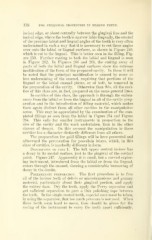Page 406 - My FlipBook
P. 406
178 THE TECHNICAL PROCEDUBES IN FILLING TEETH.
incisal edge, or about centrally between the gingival line and the
incisal edge, where the tooth is narrow labio-lingually, the enamel
of the proximo-labial and lingual angles of the tooth is very often
undermined in such a way that it is necessary to cut these angles
over onto the labial or lingual surfaces, as shown in Figure 249,
which is cut to the lingual. This is better seen in the filling. Fig-
ure 250. Further cutting to both the labial and lingual is seen
in Figure 262. In Figures 266 and 268, the cutting away of
parts of both the labial and lingual surfaces show the extreme
modification of the form of the prepared cavity. In these it will
be noted that the principal modification is caused by more or
less undermining of the enamel, requiring that portions of the
lingual or the labial enamel plates, or of both, be removed in
the preparation of the cavity. Otherwise than this, all the cavi-
ties of this class are, in fact, prepared on the same general lines.
In cavities of this class, the approach is through the embra-
sures from the labial or from the lingual in all of the cavity prep-
aration and in the introduction of filling material, which makes
them again distinct from all other cavities in the manipulative
sense. This may be appreciated by the examination of the com-
pleted fillings as seen from the labial in Figure 254 and Figure
264. This calls for smaller instruments in proportion to the
size of the cavity and the work undertaken, than in the other
classes of decays. On this account the manipulation in these
cavities has a character distinctly different from all others.
The preparation for gold fillings will be here presented and
afterward the preparation for porcelain inlays, which, in this
class of cavities, is markedly different in form.
Description of case 1. The left upper central incisor has
a decay in its mesial surface, just to the gingival of the contact
point. Figure 247. Apparently it is small, but a curved explor-
ing instrument, introduced from the labial or from the lingual,
enters through the enamel, showing a considerable burrowing of
decay in the dentin.
Preliminary preparation. The first procedure is to free
all of the incisor teeth of debris or microorganisms and gummy
material, particularly about their gingival portion, and apply
the rubber dam. Dry the teeth, apply the Perry separator and
get sufficient separation to pass a thin polishing tape between
the teeth. In the single-rooted teeth, especial care must be taken,
in using the separator, that too much pressure is not used. AVhen
these teeth seem liard to move, time should be given for the
spring of the instrument to carry the teeth apart sufficiently,


